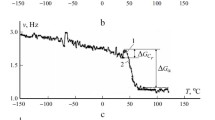The spectra of internal friction and temperature variation in the frequency of free damped torsional vibrations excited in a polyvinyl alcohol (PVA) sample in the temperature range from –150 to 0°C were investigated. Several local dissipative processes of low intensity were detected in the spectrum in the temperature range from –150 to –90°C and one more intense dissipative process in the temperature range from –70 to 0°C. According to these processes, deviations from the linear change in frequency of the vibration process were observed in the temperature-frequency relations in these temperature ranges. The mechanisms of internal friction for each of the dissipative processes are considered, and their probable structural interpretation is proposed. The defects of shear modulus arising in these processes are determined, and their contribution to the shear modulus of the entire PVA system is evaluated.

Similar content being viewed by others
References
V. A. Lomovskoy, N. A. Abaturova, N. Yu. Lomovskaya, and O. A. Khlebnikova, “Internal-friction spectra of poly (vinyl alcohol) with various molecular masses,” Polymer Sci., Ser. A., 57, No. 2, 123-130 (2015).
V. O. Startsev, M. P. Lebedev, and M. V. Molokov, “Determination of the glass-transition temperature of GRPS and CFRPS using a torsion pendulum in regimes of freely damped vibrations and quasi-stastic torsion of specimens,” Mech. Compos. Mater., 54, No. 1, 13-22 (2018).
A. Novic and B. Berry, “Relaxation Phenomena in Crystals [in Russian], M., Atomizdat (1975).
Physical Encyclopedia [in Russian], - M., The Great Russian Encyclopedia (1992).
N. Yu. Konstantinov, N. Yu. Lomovskaya, N. A. Abaturova, D. M. Sakov, and V. A. Lomovskoi, “Relaxation processes in a polyvinyl alcohol-water system,” Materialovedenie, No. 2, 15-20 (2017).
V. F. Petrenko and R. W. Whitworth, Physics of Ice, Oxford University Press (1999).
M. Y. Gillan, D. Alfy, A. P. Bartok, and G. Csany, “First-principles energetic of water clusters and ice: A many-body analysis,” J. Chem. Phys., 139, 244-594 (2013).
B. J. Murray and A. K. Bertram, “Formation and stability of cubic ice in water droplets,” Phys. Chem., 56, 186-192 (2006).
Nobuhiro Miura, Hironari Yamada, Asha Moon, “International vibration study in liquid water and ice by using far infrared spectroscopy with synchrotron radiation of MIRRORCLE 20,” Spectroch. Acta. Part A77, 1040-1053 (2010)
G. Stephen Warren, “Optical constants of ice from the ultraviolet to the microwave,” Appl. Optics, 23, No. 2, 1206-1215 (1984).
Author information
Authors and Affiliations
Corresponding author
Additional information
Translated from Mekhanika Kompozitnykh Materialov, Vol. 54, No. 6, pp. 1173-1180, November-December, 2018.
Rights and permissions
About this article
Cite this article
Lomovskoy, V.A., Abaturova, N.A., Lomovskaya, N.Y. et al. Low-Temperature Local Dissipative Processes in Polyvinyl Alcohol. Mech Compos Mater 54, 815–820 (2019). https://doi.org/10.1007/s11029-019-9785-5
Received:
Revised:
Published:
Issue Date:
DOI: https://doi.org/10.1007/s11029-019-9785-5



